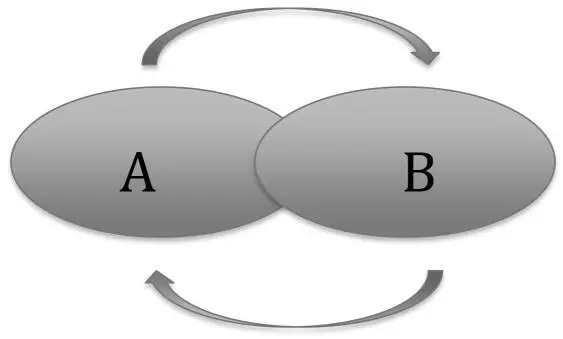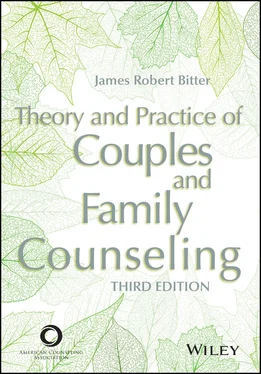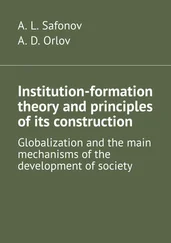James Robert Bitter - Theory and Practice of Couples and Family Counseling
Здесь есть возможность читать онлайн «James Robert Bitter - Theory and Practice of Couples and Family Counseling» — ознакомительный отрывок электронной книги совершенно бесплатно, а после прочтения отрывка купить полную версию. В некоторых случаях можно слушать аудио, скачать через торрент в формате fb2 и присутствует краткое содержание. Жанр: unrecognised, на английском языке. Описание произведения, (предисловие) а так же отзывы посетителей доступны на портале библиотеки ЛибКат.
- Название:Theory and Practice of Couples and Family Counseling
- Автор:
- Жанр:
- Год:неизвестен
- ISBN:нет данных
- Рейтинг книги:5 / 5. Голосов: 1
-
Избранное:Добавить в избранное
- Отзывы:
-
Ваша оценка:
- 100
- 1
- 2
- 3
- 4
- 5
Theory and Practice of Couples and Family Counseling: краткое содержание, описание и аннотация
Предлагаем к чтению аннотацию, описание, краткое содержание или предисловие (зависит от того, что написал сам автор книги «Theory and Practice of Couples and Family Counseling»). Если вы не нашли необходимую информацию о книге — напишите в комментариях, мы постараемся отыскать её.
Theory and Practice of Couples and Family Counseling — читать онлайн ознакомительный отрывок
Ниже представлен текст книги, разбитый по страницам. Система сохранения места последней прочитанной страницы, позволяет с удобством читать онлайн бесплатно книгу «Theory and Practice of Couples and Family Counseling», без необходимости каждый раз заново искать на чём Вы остановились. Поставьте закладку, и сможете в любой момент перейти на страницу, на которой закончили чтение.
Интервал:
Закладка:
Minuchin transformed the Philadelphia Child Guidance Clinic into a training center for family therapists. Among his many innovations, he also trained community members to be paraprofessional therapists. His emphasis on working with the poor brought other major figures in family counseling into his programs, including Harry Aponte, Jorge Colapinto, and Charles Fishman. In 1981, Minuchin moved back to New York City, where he would eventually establish what is now the Minuchin Center for the Family, a training center currently directed by Jorge Colapinto. In recent years, Minuchin has mellowed a bit, and he has begun to look at family practice as a journey to hope, healing, and transformation (see S. Minuchin et al., 2006, 2007; S. Minuchin & Nichols, 1993).
Family Systems, Cybernetics, Bateson, and MRI
Perhaps I should warn you now about this next part of the chapter: It is not going to be easy to understand immediately . So why am I going to talk about systemic thinking and cybernetics at all? Part of the answer is that these concepts, both historically and in current practice, inform the way family practitioners approach their work. Part of the answer is that it will challenge you to move from an individual focus to an interactive one. And part of the answer is that having this knowledge may create new possibilities for the ways in which you will choose to make a difference in the families you see.
Focusing on the family as a unit rather than focusing on the individual brings about an entirely new way of considering what is going on. Such a focus moves us away from evaluating individual actions toward understanding interaction—and even sequences of interaction. When an individual behaves in a certain way, especially one that seems peculiar to a large part of the community or culture, we have a tendency to ask why. The answers we posit are usually in the form of cause and effect: B happened because of A; A caused B to happen. It might be diagrammed as in Figure 2.1.

FIGURE 2.1• A Causes B
When we think in terms of interaction, however, we can never really know why or what caused the interaction. We can describe the interaction and note what is happening, how it is going, and maybe even what purpose the interaction seeks or serves, but in an interaction, A and B occur in relation to each other. A and B may not have caused each other, but they certainly were an influence on each other. If we diagrammed a relational interaction, it might look like Figure 2.2.
If we replace any part of the interaction with someone or something else, the interaction would be different. If Ann says to Bob, “You never pick up around the house,” and Bob responds with irritation, “I like it messy; it has a lived-in look,” that is one interaction, and it is characteristic only of Ann and Bob at that moment in time and in that context. Let us say, however, that we replace Ann with Arthur and that Arthur and Bob are gay men who own a home together. Arthur says, “We’re having people over tonight. Maybe we should clean the place up.” Bob responds, but with a bemused tone in his voice: “I like it messy; it has a lived-in look.” Notice that Bob has not changed a thing about the content of his response: He has used exactly the same words. Still the meaning is different because his tone carries a metamessage. Metamessages are directions about how content is to be taken. It may be tempting to say that Bob responds with a different metamessage because of who is speaking, that is, whether it is Ann or Arthur. But such a simplification would not take into account a real difference in relationship, the impact of gender issues or being gay men in a heterosexist society, or even the choices Bob makes in how to focus his attention on what Ann or Arthur might say. Indeed, the minute we try to imply linear cause and effect, we are forced into a simplistic conceptualization that all but loses real meaning.

FIGURE 2.2• Relational Interaction
Okay, here comes the really hard stuff. Anthropologist Gregory Bateson (1972) adopted the term “cybernetics” from the work of Norbert Wiener (1948). Cybernetics is an epistemology of systems, a way of thinking and conceptualizing how systems work, how they self-regulate, and how they remain stable. Wiener was a mathematician, and he primarily applied his ideas to machines and the development of computers. He was interested in the ways in which feedback could be used to correct and guide a system in its effort to be effective in different contexts. Among other things, feedback made it possible for systems to use past performance to regulate current processes. It became possible for systems to anticipate and influence future changes by choosing and selecting feedback to pass along now. Family members are constantly engaged in feedback, in the maintenance of family routines and rules, and in communications that affect the ways in which the family operates and faces future challenges. Each action or communication from an individual family member affects all others in the family, and in turn the responses from other family members also affect the individual in a kind of circular fashion. It is from cybernetics that we get the concepts of circular causality and feedback loops.
Circular causality is the idea that A causes B, which causes C, which causes D, and so on, and each of these entities (letters) acts on and is affected by every other entity in the system. In a car, which is a closed system, the ignition of gasoline may cause pistons to pump, which generates power for a host of other mechanical parts to move in line with directions received from shifting gears. But at the simplest level, the size of the piston also influences how much gasoline enters the chamber, and a breakdown in any part of the car’s system generally shuts down the whole system. Today modern cars are so complicated that they are regulated and checked by computers, the very machines that first benefited from the development of feedback loops.
A feedback loop is the process that any system uses to assess and bring correcting information back into the system: These feedback loops either initiate change (called a positive feedback loop ) or deter change (called a negative feedback loop ). The words “positive” and “negative,” in this sense, are not used to indicate good and bad or right and wrong; these are evaluations that can be asserted only through linear causality. Rather, these terms relate only to whether they promote change (positive) or not (negative).
In families, a bad or wrong individual behavior may lead to either a positive or negative feedback loop. For example, an adolescent uses cocaine (a bad behavior), is caught by the police in a public setting, and is charged with possession and use. His father declares that he “cannot handle this crazy family anymore” and disappears, leaving the mother and son to cope on their own. Change has occurred as a result of a positive feedback loop—even though all of the people in this system may feel lousy. In a different family system facing the same problem with their adolescent, two parents who are on the verge of divorce may pull together enough to focus on and try to address their child’s problems. In this case, the system maintains itself through a negative feedback loop—even though we may think that staying together for the adolescent is really a positive thing. Cybernetics therefore is actually the science of communication, and it can be applied to machines or humans with equal success.
Читать дальшеИнтервал:
Закладка:
Похожие книги на «Theory and Practice of Couples and Family Counseling»
Представляем Вашему вниманию похожие книги на «Theory and Practice of Couples and Family Counseling» списком для выбора. Мы отобрали схожую по названию и смыслу литературу в надежде предоставить читателям больше вариантов отыскать новые, интересные, ещё непрочитанные произведения.
Обсуждение, отзывы о книге «Theory and Practice of Couples and Family Counseling» и просто собственные мнения читателей. Оставьте ваши комментарии, напишите, что Вы думаете о произведении, его смысле или главных героях. Укажите что конкретно понравилось, а что нет, и почему Вы так считаете.












